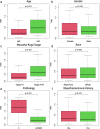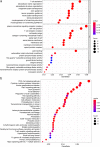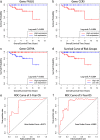Significance of tumor mutation burden and immune infiltration in thymic epithelial tumors
- PMID: 34033229
- PMCID: PMC8258363
- DOI: 10.1111/1759-7714.14002
Significance of tumor mutation burden and immune infiltration in thymic epithelial tumors
Abstract
Background: Thymic epithelial tumors (TETs) are relatively rare malignant thoracic tumors. Tumor mutation burden (TMB) and immune infiltration play important roles in tumorigenesis.
Methods: Research data was obtained using the Cancer Genome Atlas (TCGA) database to evaluate the landscape of tumor mutations, related factors, and relationship of prognosis. The CIBERSORT algorithm was used to evaluate immune cell infiltration in TETs and its relationship with TMB. Immune-related differentially expressed genes (irDEGs) were identified. Hub irDEGs independently related to prognosis were analyzed using univariate and multivariate Cox proportional hazard models. A survival signature was constructed from hub irDEGs.
Results: A total of 122 patients were included in this study. GTF2I was the most common gene mutation. Higher TMB was significantly associated with the later stage, more advanced pathological type, and older age. The overall survival (OS) of patients in the low-TMB group was significantly better. There was no significant correlation between TMB levels and PD-L1 expression. Enrichment analysis showed that DEGs were mainly involved in the P13K-Akt signaling pathway. There were significant differences in macrophage and other types of immune cell infiltration between the high- and low-TMB groups. CCR5, FASLG, and CD79A independently relating to prognosis were screened from 391 irDEGs. The low-risk group had a significantly better prognosis than the high-risk group based on the signature, which has a good predictive effect on OS.
Conclusions: In this study, TETs patients with high TMB had a significantly poor prognosis and an immune-related gene signature was found to effectively evaluate the long-term prognosis.
Keywords: immune infiltration; prognosis; thymic epithelial tumors; thymus; tumor mutation burden.
© 2021 The Authors. Thoracic Cancer published by China Lung Oncology Group and John Wiley & Sons Australia, Ltd.
Conflict of interest statement
The authors declare that the research was conducted in the absence of any commercial or financial relationships that could be construed as a potential conflict of interest.
Figures









Similar articles
-
The Prognostic Value of Tumor Mutation Burden and Immune Cell Infiltration in Thymic Epithelial Tumors.Ann Clin Lab Sci. 2021 Jan;51(1):44-54. Ann Clin Lab Sci. 2021. PMID: 33653780
-
Thymic epithelial tumors: examining the GTF2I mutation and developing a novel prognostic signature with LncRNA pairs to predict tumor recurrence.BMC Genomics. 2022 Sep 16;23(1):656. doi: 10.1186/s12864-022-08880-3. BMC Genomics. 2022. PMID: 36114454 Free PMC article.
-
Tumor Mutation Burden, Immune Cell Infiltration, and Construction of Immune-Related Genes Prognostic Model in Head and Neck Cancer.Int J Med Sci. 2021 Jan 1;18(1):226-238. doi: 10.7150/ijms.51064. eCollection 2021. Int J Med Sci. 2021. PMID: 33390791 Free PMC article.
-
The Molecular Landscape of Thymic Epithelial Tumors: A Comprehensive Review.Int J Mol Sci. 2024 Jan 26;25(3):1554. doi: 10.3390/ijms25031554. Int J Mol Sci. 2024. PMID: 38338833 Free PMC article. Review.
-
Immunotherapy in thymic epithelial tumors: tissue predictive biomarkers for immune checkpoint inhibitors.Explor Target Antitumor Ther. 2024;5(3):465-476. doi: 10.37349/etat.2024.00229. Epub 2024 May 21. Explor Target Antitumor Ther. 2024. PMID: 38966177 Free PMC article. Review.
Cited by
-
Balancing the Risk of Adverse Events against the Efficacy of Immunotherapy in Advanced Thymic Epithelial Tumors.Cancers (Basel). 2022 Dec 31;15(1):289. doi: 10.3390/cancers15010289. Cancers (Basel). 2022. PMID: 36612283 Free PMC article. Review.
-
Identification of genes predicting chemoresistance and short survival in ovarian cancer.Transl Cancer Res. 2024 Aug 31;13(8):4354-4371. doi: 10.21037/tcr-23-2157. Epub 2024 Aug 6. Transl Cancer Res. 2024. PMID: 39262489 Free PMC article.
-
Molecular genetic characteristics of thymic epithelial tumors with distinct histological subtypes.Cancer Med. 2023 May;12(9):10575-10586. doi: 10.1002/cam4.5795. Epub 2023 Mar 14. Cancer Med. 2023. PMID: 36916520 Free PMC article.
-
Thymic Epithelial Tumors: An Evolving Field.Life (Basel). 2023 Jan 22;13(2):314. doi: 10.3390/life13020314. Life (Basel). 2023. PMID: 36836670 Free PMC article. Review.
-
Prognostic markers of ferroptosis-related long non-coding RNA in lung adenocarcinomas.Front Genet. 2023 Feb 27;14:1118273. doi: 10.3389/fgene.2023.1118273. eCollection 2023. Front Genet. 2023. PMID: 36923797 Free PMC article.
References
-
- Engels EA, Pfeiffer RM. Malignant thymoma in the United States: demographic patterns in incidence and associations with subsequent malignancies. Int J Cancer. 2003;105:546–51. - PubMed
-
- Hasserjian RP, Strobel P, Marx A. Pathology of thymic tumors. Semin Thorac Cardiovasc Surg. 2005;17:2–11. - PubMed
-
- Schumacher TN, Schreiber RD. Neoantigens in cancer immunotherapy. Science. 2015;348:69–74. - PubMed
MeSH terms
Substances
Supplementary concepts
LinkOut - more resources
Full Text Sources
Other Literature Sources
Medical
Research Materials
Miscellaneous

